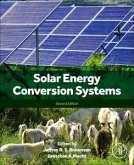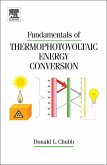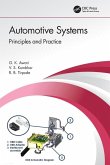- Broschiertes Buch
- Merkliste
- Auf die Merkliste
- Bewerten Bewerten
- Teilen
- Produkt teilen
- Produkterinnerung
- Produkterinnerung
The variable gain control method is a new construction technique for the control of nonlinear systems.
Andere Kunden interessierten sich auch für
![Solar Energy Conversion Systems Solar Energy Conversion Systems]() Jeffrey R S BrownsonSolar Energy Conversion Systems124,99 €
Jeffrey R S BrownsonSolar Energy Conversion Systems124,99 €![Modeling Tools for Planning Sustainable Biomass and Waste Conversion Into Energy and Chemicals Modeling Tools for Planning Sustainable Biomass and Waste Conversion Into Energy and Chemicals]() Modeling Tools for Planning Sustainable Biomass and Waste Conversion Into Energy and Chemicals156,99 €
Modeling Tools for Planning Sustainable Biomass and Waste Conversion Into Energy and Chemicals156,99 €![Fundamentals of Thermophotovoltaic Energy Conversion Fundamentals of Thermophotovoltaic Energy Conversion]() Donald ChubbFundamentals of Thermophotovoltaic Energy Conversion142,99 €
Donald ChubbFundamentals of Thermophotovoltaic Energy Conversion142,99 €![Applied Mathematical Modeling and Analysis in Renewable Energy Applied Mathematical Modeling and Analysis in Renewable Energy]() Applied Mathematical Modeling and Analysis in Renewable Energy60,99 €
Applied Mathematical Modeling and Analysis in Renewable Energy60,99 €![Automotive Systems Automotive Systems]() G K AwariAutomotive Systems77,99 €
G K AwariAutomotive Systems77,99 €![Distributed Generation Distributed Generation]() Distributed Generation84,99 €
Distributed Generation84,99 €![Ocean Wave Energy Conversion Ocean Wave Energy Conversion]() Michael E MccormickOcean Wave Energy Conversion13,99 €
Michael E MccormickOcean Wave Energy Conversion13,99 €-
-
-
The variable gain control method is a new construction technique for the control of nonlinear systems.
Produktdetails
- Produktdetails
- Verlag: Taylor & Francis Ltd (Sales)
- Seitenzahl: 180
- Erscheinungstermin: 7. Oktober 2024
- Englisch
- Abmessung: 234mm x 156mm x 10mm
- Gewicht: 277g
- ISBN-13: 9781032492728
- ISBN-10: 1032492724
- Artikelnr.: 71626952
- Herstellerkennzeichnung
- Libri GmbH
- Europaallee 1
- 36244 Bad Hersfeld
- gpsr@libri.de
- Verlag: Taylor & Francis Ltd (Sales)
- Seitenzahl: 180
- Erscheinungstermin: 7. Oktober 2024
- Englisch
- Abmessung: 234mm x 156mm x 10mm
- Gewicht: 277g
- ISBN-13: 9781032492728
- ISBN-10: 1032492724
- Artikelnr.: 71626952
- Herstellerkennzeichnung
- Libri GmbH
- Europaallee 1
- 36244 Bad Hersfeld
- gpsr@libri.de
Chenghui Zhang, Le Chang, Cheng Fu
Preface Authors 1 Introduction 1.1 High/Low Gain Control Design Method
1.1.1 High Gain Feedback Control 1.1.2 Low Gain Feedback Control 1.2
Challenges 1.2.1 Complex Nonlinearities 1.2.2 Multi Control Gains 1.3
Preview of Chapters SECTION I: CONTROL DESIGN FOR SINGLE INPUT SYSTEMS 2
Increasing Gain Feedback Control 2.1 Problem Description 2.2 Control Design
2.3 Stability Analysis 2.4 Simulation 2.5 Notes 3 Output Feedback Control
3.1 Problem Description 3.2 Control Design 3.3 Stability Analysis 3.4
Simulation 3.5 Notes 4 Fixed-Time Feedback Control 4.1 Problem Formulation
4.1.1 Fixed-Time Stability 4.1.2 Problem Description 4.2 Control Design 4.3
Stability Analysis 4.4 Simulation 4.5 Notes 5 Decreasing Gain Feedback
Control 5.1 Problem Description 5.2 Control Design 5.3 Stability Analysis
5.4 Simulation 5.5 Notes 6 Asymptotic Stabilization of Time-Delay Systems
6.1 Problem Description 6.2 Control Design 6.3 Stability Analysis 6.4
Simulation 6.5 Notes SECTION II: CONTROL DESIGN FOR MULTI INPUT SYSTEMS 7
Control Design of Nonholonomic Systems 7.1 Problem Description 7.2 Control
Design 7.3 Stability Analysis 7.4 Simulation 7.5 Notes 8 Decentralized
Control for Large-Scale Systems 8.1 Problem Description 8.2 Decentralized
Control With Constant Parameters 8.2.1 Control Design 8.2.2 Stability
Analysis 8.2.3 Simulation 8.3 Decentralized Control With Global Dynamic
Parameters 8.3.1 Control Design 8.3.2 Stability Analysis 8.3.3 Simulation
8.4 Decentralized Control With Distributed Regulating Gains 8.4.1 Control
Design 8.4.2 Stability Analysis 8.4.3 Simulation 8.5 Notes 9 Distributed
Control for Multi-Agent Systems 9.1 Problem Formulation 9.1.1 Network
Topology 9.1.2 System Dynamics 9.1.3 Problem Description 9.2 Low Gain
Feedback Control Protocol 9.2.1 Control Protocol 9.2.2 Consensus Analysis
9.2.3 Simulation 9.3 Time-Varying Control Protocol 9.3.1 Protocol Design
9.3.2 Consensus Analysis 9.3.3 Simulation 9.4 Notes SECTION III:
APPLICATIONS IN ENERGY CONVERSION 10 Variable Gain Control of Three-Phase
AC/DC Power Converter 10.1 Background 10.2 Mathematical Model and
Preliminaries 10.3 DC-link Voltage Control 10.3.1 Direct Gain Control
Design 10.3.2 Dynamic Gain Control Design 10.4 Results 10.4.1 Controller
Inserting Performance 10.4.2 Load Disturbance 10.5 Notes 11 Variable Gain
Control of Permanent Magnet Synchronous Motor Speed Regulation System 11.1
Background 11.2 Mathematical Model and Preliminaries 11.3 Fixed-Time
Control Design 11.4 Case Studies 11.4.1 Case 1: Start-up Performance 11.4.2
Case 2: Different Working Conditions 11.5 Notes 12 Direct Gain
Control-Based Distributed Robust Secondary Control of Islanded Microgrids
12.1 Background 12.2 Problem Formulation 12.2.1 Communication Network
12.2.2 Mathematical Model 12.3 Distributed Secondary Voltage Control 12.4
Distributed Frequency Control and Active Power Sharing 12.5 Case Studies
12.5.1 Case 1: Load Disturbances 12.5.2 Case 2: Parameter Uncertainties
12.6 Notes 13 Conclusions and Future Challenges 13.1 Conclusions 13.2
Future Challenges Appendix References
1.1.1 High Gain Feedback Control 1.1.2 Low Gain Feedback Control 1.2
Challenges 1.2.1 Complex Nonlinearities 1.2.2 Multi Control Gains 1.3
Preview of Chapters SECTION I: CONTROL DESIGN FOR SINGLE INPUT SYSTEMS 2
Increasing Gain Feedback Control 2.1 Problem Description 2.2 Control Design
2.3 Stability Analysis 2.4 Simulation 2.5 Notes 3 Output Feedback Control
3.1 Problem Description 3.2 Control Design 3.3 Stability Analysis 3.4
Simulation 3.5 Notes 4 Fixed-Time Feedback Control 4.1 Problem Formulation
4.1.1 Fixed-Time Stability 4.1.2 Problem Description 4.2 Control Design 4.3
Stability Analysis 4.4 Simulation 4.5 Notes 5 Decreasing Gain Feedback
Control 5.1 Problem Description 5.2 Control Design 5.3 Stability Analysis
5.4 Simulation 5.5 Notes 6 Asymptotic Stabilization of Time-Delay Systems
6.1 Problem Description 6.2 Control Design 6.3 Stability Analysis 6.4
Simulation 6.5 Notes SECTION II: CONTROL DESIGN FOR MULTI INPUT SYSTEMS 7
Control Design of Nonholonomic Systems 7.1 Problem Description 7.2 Control
Design 7.3 Stability Analysis 7.4 Simulation 7.5 Notes 8 Decentralized
Control for Large-Scale Systems 8.1 Problem Description 8.2 Decentralized
Control With Constant Parameters 8.2.1 Control Design 8.2.2 Stability
Analysis 8.2.3 Simulation 8.3 Decentralized Control With Global Dynamic
Parameters 8.3.1 Control Design 8.3.2 Stability Analysis 8.3.3 Simulation
8.4 Decentralized Control With Distributed Regulating Gains 8.4.1 Control
Design 8.4.2 Stability Analysis 8.4.3 Simulation 8.5 Notes 9 Distributed
Control for Multi-Agent Systems 9.1 Problem Formulation 9.1.1 Network
Topology 9.1.2 System Dynamics 9.1.3 Problem Description 9.2 Low Gain
Feedback Control Protocol 9.2.1 Control Protocol 9.2.2 Consensus Analysis
9.2.3 Simulation 9.3 Time-Varying Control Protocol 9.3.1 Protocol Design
9.3.2 Consensus Analysis 9.3.3 Simulation 9.4 Notes SECTION III:
APPLICATIONS IN ENERGY CONVERSION 10 Variable Gain Control of Three-Phase
AC/DC Power Converter 10.1 Background 10.2 Mathematical Model and
Preliminaries 10.3 DC-link Voltage Control 10.3.1 Direct Gain Control
Design 10.3.2 Dynamic Gain Control Design 10.4 Results 10.4.1 Controller
Inserting Performance 10.4.2 Load Disturbance 10.5 Notes 11 Variable Gain
Control of Permanent Magnet Synchronous Motor Speed Regulation System 11.1
Background 11.2 Mathematical Model and Preliminaries 11.3 Fixed-Time
Control Design 11.4 Case Studies 11.4.1 Case 1: Start-up Performance 11.4.2
Case 2: Different Working Conditions 11.5 Notes 12 Direct Gain
Control-Based Distributed Robust Secondary Control of Islanded Microgrids
12.1 Background 12.2 Problem Formulation 12.2.1 Communication Network
12.2.2 Mathematical Model 12.3 Distributed Secondary Voltage Control 12.4
Distributed Frequency Control and Active Power Sharing 12.5 Case Studies
12.5.1 Case 1: Load Disturbances 12.5.2 Case 2: Parameter Uncertainties
12.6 Notes 13 Conclusions and Future Challenges 13.1 Conclusions 13.2
Future Challenges Appendix References
Preface Authors 1 Introduction 1.1 High/Low Gain Control Design Method
1.1.1 High Gain Feedback Control 1.1.2 Low Gain Feedback Control 1.2
Challenges 1.2.1 Complex Nonlinearities 1.2.2 Multi Control Gains 1.3
Preview of Chapters SECTION I: CONTROL DESIGN FOR SINGLE INPUT SYSTEMS 2
Increasing Gain Feedback Control 2.1 Problem Description 2.2 Control Design
2.3 Stability Analysis 2.4 Simulation 2.5 Notes 3 Output Feedback Control
3.1 Problem Description 3.2 Control Design 3.3 Stability Analysis 3.4
Simulation 3.5 Notes 4 Fixed-Time Feedback Control 4.1 Problem Formulation
4.1.1 Fixed-Time Stability 4.1.2 Problem Description 4.2 Control Design 4.3
Stability Analysis 4.4 Simulation 4.5 Notes 5 Decreasing Gain Feedback
Control 5.1 Problem Description 5.2 Control Design 5.3 Stability Analysis
5.4 Simulation 5.5 Notes 6 Asymptotic Stabilization of Time-Delay Systems
6.1 Problem Description 6.2 Control Design 6.3 Stability Analysis 6.4
Simulation 6.5 Notes SECTION II: CONTROL DESIGN FOR MULTI INPUT SYSTEMS 7
Control Design of Nonholonomic Systems 7.1 Problem Description 7.2 Control
Design 7.3 Stability Analysis 7.4 Simulation 7.5 Notes 8 Decentralized
Control for Large-Scale Systems 8.1 Problem Description 8.2 Decentralized
Control With Constant Parameters 8.2.1 Control Design 8.2.2 Stability
Analysis 8.2.3 Simulation 8.3 Decentralized Control With Global Dynamic
Parameters 8.3.1 Control Design 8.3.2 Stability Analysis 8.3.3 Simulation
8.4 Decentralized Control With Distributed Regulating Gains 8.4.1 Control
Design 8.4.2 Stability Analysis 8.4.3 Simulation 8.5 Notes 9 Distributed
Control for Multi-Agent Systems 9.1 Problem Formulation 9.1.1 Network
Topology 9.1.2 System Dynamics 9.1.3 Problem Description 9.2 Low Gain
Feedback Control Protocol 9.2.1 Control Protocol 9.2.2 Consensus Analysis
9.2.3 Simulation 9.3 Time-Varying Control Protocol 9.3.1 Protocol Design
9.3.2 Consensus Analysis 9.3.3 Simulation 9.4 Notes SECTION III:
APPLICATIONS IN ENERGY CONVERSION 10 Variable Gain Control of Three-Phase
AC/DC Power Converter 10.1 Background 10.2 Mathematical Model and
Preliminaries 10.3 DC-link Voltage Control 10.3.1 Direct Gain Control
Design 10.3.2 Dynamic Gain Control Design 10.4 Results 10.4.1 Controller
Inserting Performance 10.4.2 Load Disturbance 10.5 Notes 11 Variable Gain
Control of Permanent Magnet Synchronous Motor Speed Regulation System 11.1
Background 11.2 Mathematical Model and Preliminaries 11.3 Fixed-Time
Control Design 11.4 Case Studies 11.4.1 Case 1: Start-up Performance 11.4.2
Case 2: Different Working Conditions 11.5 Notes 12 Direct Gain
Control-Based Distributed Robust Secondary Control of Islanded Microgrids
12.1 Background 12.2 Problem Formulation 12.2.1 Communication Network
12.2.2 Mathematical Model 12.3 Distributed Secondary Voltage Control 12.4
Distributed Frequency Control and Active Power Sharing 12.5 Case Studies
12.5.1 Case 1: Load Disturbances 12.5.2 Case 2: Parameter Uncertainties
12.6 Notes 13 Conclusions and Future Challenges 13.1 Conclusions 13.2
Future Challenges Appendix References
1.1.1 High Gain Feedback Control 1.1.2 Low Gain Feedback Control 1.2
Challenges 1.2.1 Complex Nonlinearities 1.2.2 Multi Control Gains 1.3
Preview of Chapters SECTION I: CONTROL DESIGN FOR SINGLE INPUT SYSTEMS 2
Increasing Gain Feedback Control 2.1 Problem Description 2.2 Control Design
2.3 Stability Analysis 2.4 Simulation 2.5 Notes 3 Output Feedback Control
3.1 Problem Description 3.2 Control Design 3.3 Stability Analysis 3.4
Simulation 3.5 Notes 4 Fixed-Time Feedback Control 4.1 Problem Formulation
4.1.1 Fixed-Time Stability 4.1.2 Problem Description 4.2 Control Design 4.3
Stability Analysis 4.4 Simulation 4.5 Notes 5 Decreasing Gain Feedback
Control 5.1 Problem Description 5.2 Control Design 5.3 Stability Analysis
5.4 Simulation 5.5 Notes 6 Asymptotic Stabilization of Time-Delay Systems
6.1 Problem Description 6.2 Control Design 6.3 Stability Analysis 6.4
Simulation 6.5 Notes SECTION II: CONTROL DESIGN FOR MULTI INPUT SYSTEMS 7
Control Design of Nonholonomic Systems 7.1 Problem Description 7.2 Control
Design 7.3 Stability Analysis 7.4 Simulation 7.5 Notes 8 Decentralized
Control for Large-Scale Systems 8.1 Problem Description 8.2 Decentralized
Control With Constant Parameters 8.2.1 Control Design 8.2.2 Stability
Analysis 8.2.3 Simulation 8.3 Decentralized Control With Global Dynamic
Parameters 8.3.1 Control Design 8.3.2 Stability Analysis 8.3.3 Simulation
8.4 Decentralized Control With Distributed Regulating Gains 8.4.1 Control
Design 8.4.2 Stability Analysis 8.4.3 Simulation 8.5 Notes 9 Distributed
Control for Multi-Agent Systems 9.1 Problem Formulation 9.1.1 Network
Topology 9.1.2 System Dynamics 9.1.3 Problem Description 9.2 Low Gain
Feedback Control Protocol 9.2.1 Control Protocol 9.2.2 Consensus Analysis
9.2.3 Simulation 9.3 Time-Varying Control Protocol 9.3.1 Protocol Design
9.3.2 Consensus Analysis 9.3.3 Simulation 9.4 Notes SECTION III:
APPLICATIONS IN ENERGY CONVERSION 10 Variable Gain Control of Three-Phase
AC/DC Power Converter 10.1 Background 10.2 Mathematical Model and
Preliminaries 10.3 DC-link Voltage Control 10.3.1 Direct Gain Control
Design 10.3.2 Dynamic Gain Control Design 10.4 Results 10.4.1 Controller
Inserting Performance 10.4.2 Load Disturbance 10.5 Notes 11 Variable Gain
Control of Permanent Magnet Synchronous Motor Speed Regulation System 11.1
Background 11.2 Mathematical Model and Preliminaries 11.3 Fixed-Time
Control Design 11.4 Case Studies 11.4.1 Case 1: Start-up Performance 11.4.2
Case 2: Different Working Conditions 11.5 Notes 12 Direct Gain
Control-Based Distributed Robust Secondary Control of Islanded Microgrids
12.1 Background 12.2 Problem Formulation 12.2.1 Communication Network
12.2.2 Mathematical Model 12.3 Distributed Secondary Voltage Control 12.4
Distributed Frequency Control and Active Power Sharing 12.5 Case Studies
12.5.1 Case 1: Load Disturbances 12.5.2 Case 2: Parameter Uncertainties
12.6 Notes 13 Conclusions and Future Challenges 13.1 Conclusions 13.2
Future Challenges Appendix References









